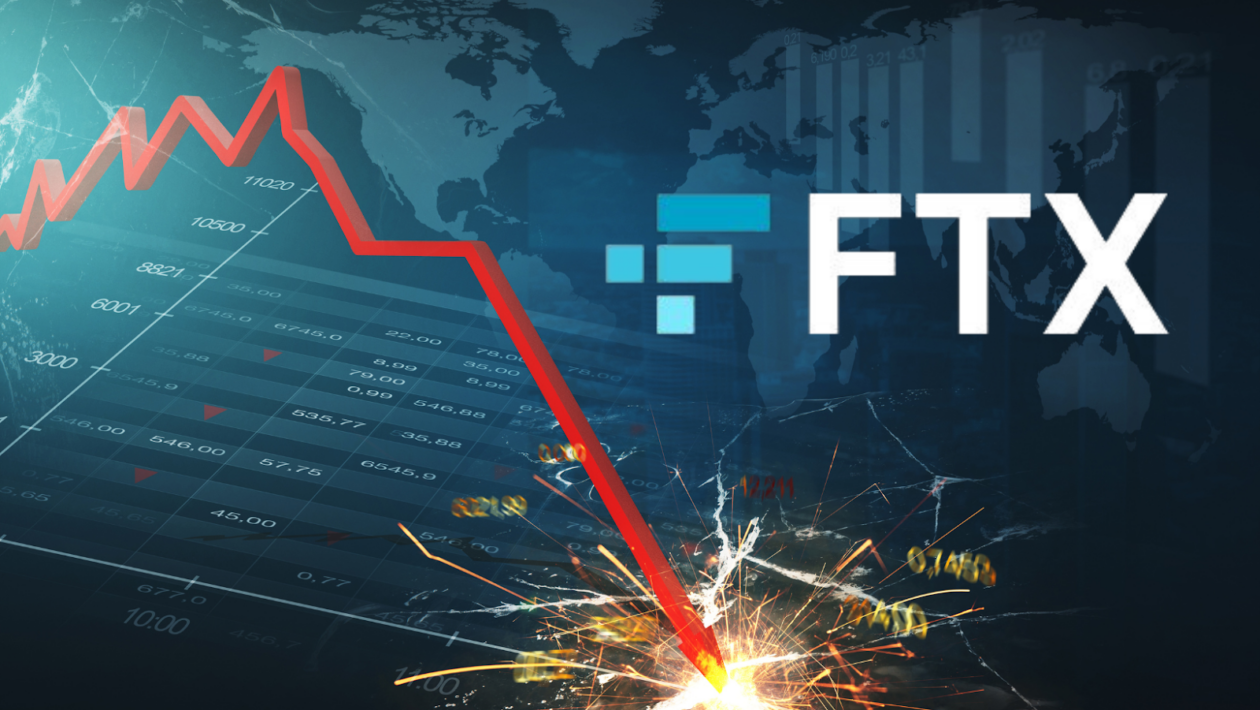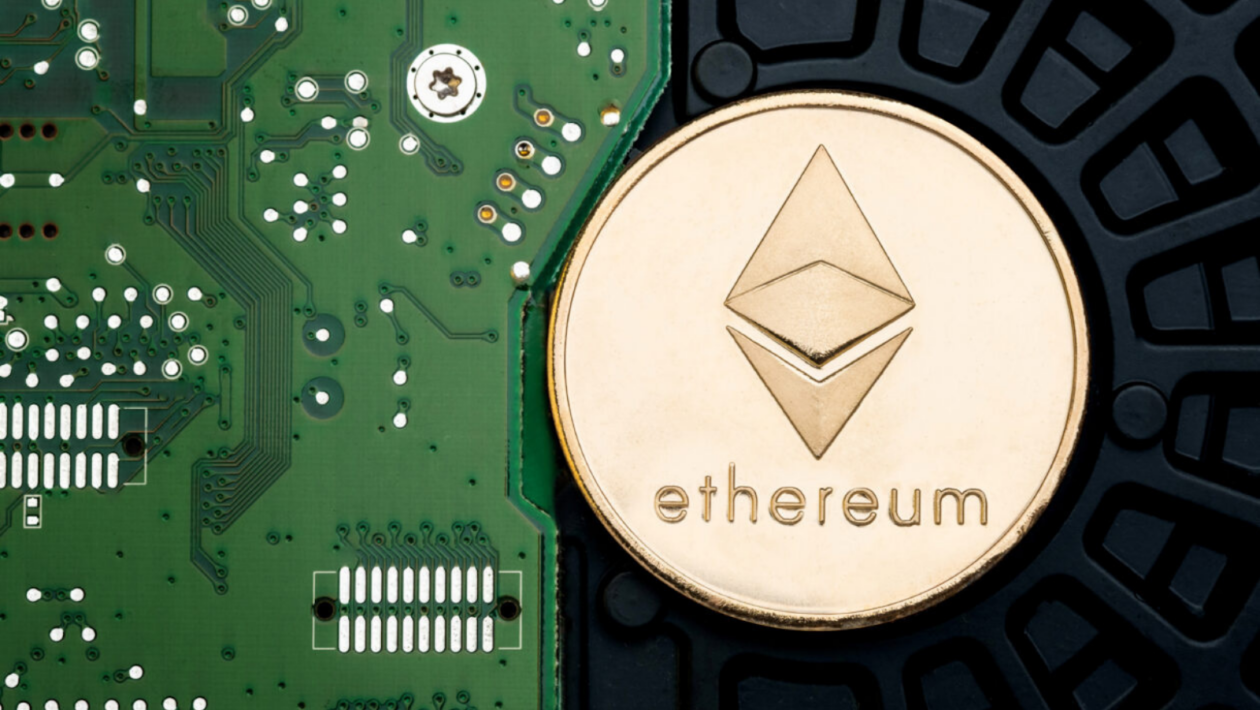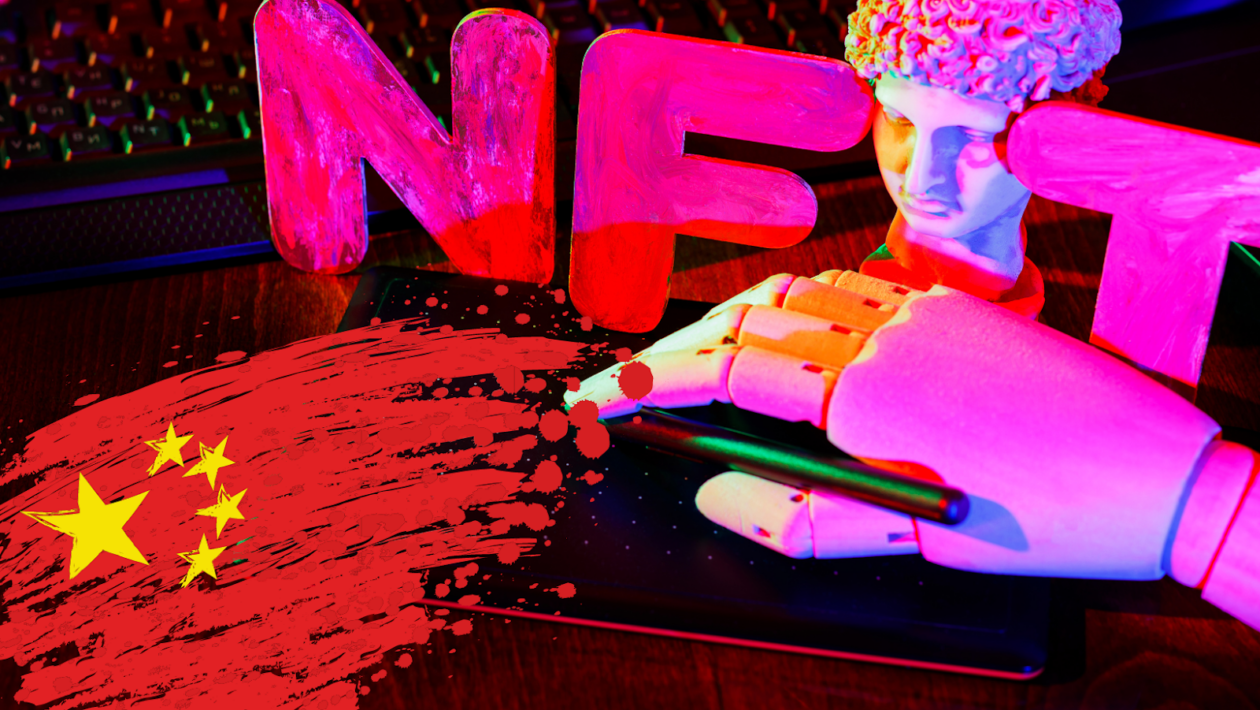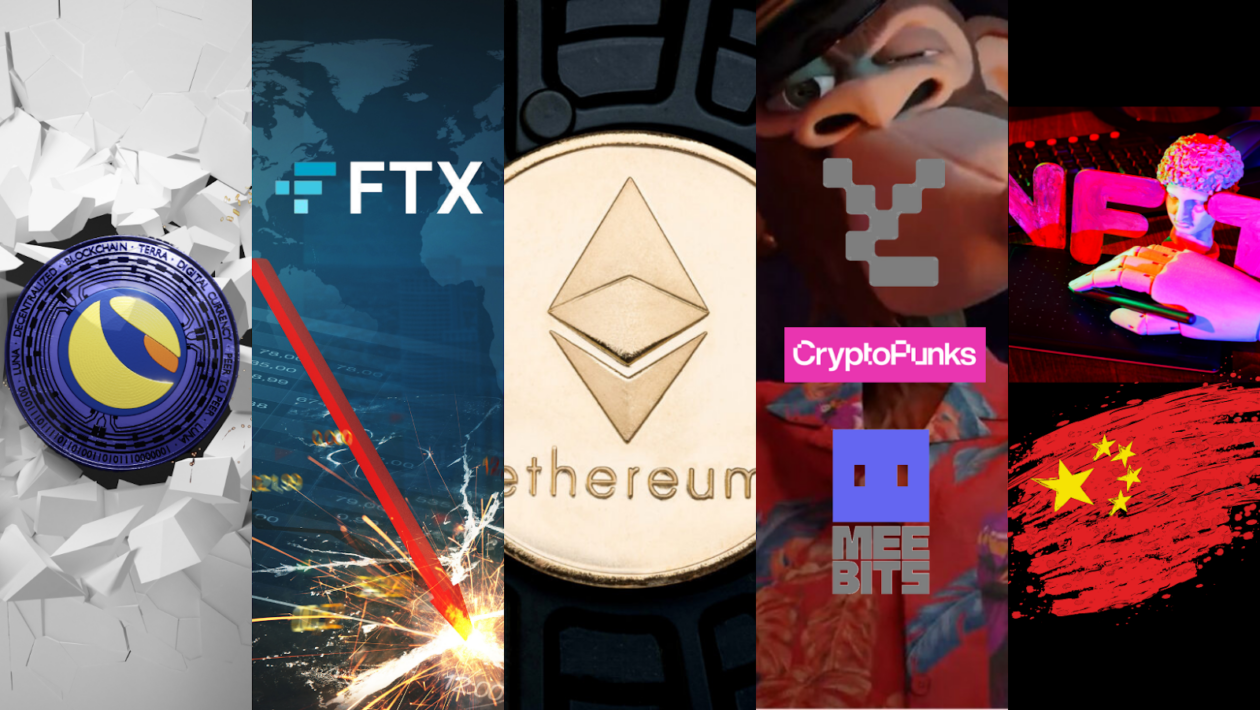In this issue
- Terra: Crypto catastrophe
- FTX: Lessons to learn
- Ethereum’s Merge: In the sun
- Yuga Labs: Monkey business
- NTFs in China: Cat-and-mouse
From the editor’s desk
Dear Reader,
If you feel as though you’ve lived 2022 in dog years, you’re not alone. The past 12 months have been a trying time for all in the crypto community as we’ve watched investors lose billions of dollars, once-feted crypto companies go to the wall, and digital asset values remain in the doldrums.
There’s no denying it’s been a tough year, and when FTX went belly up amid multiple allegations of misconduct and malfeasance, one might have been forgiven for thinking the game was up. After all, if such a wunderkind as Sam Bankman-Fried was once thought to be could get it so wrong, was anything in this still-hardly-regulated space safe?
The implosion of FTX amid its governance vacuum dealt a bitter blow to an industry still reeling from the almost overnight demise of Terra and the US$45 billion of market cap it took to the grave, but it’s critical to remember that both of these wholly avoidable developments were the result of the actions of individual people. The technology that makes digital assets such a game-changing asset class didn’t fail — the failures were down to those at the controls.
That’s not to say the industry can engineer its way to bulletproof infallibility by technological means alone, but the point stands that the two cave-ins — and the numerous others they triggered — took place despite the technology, not because of it.
Within the sector, this year has seen a growing recognition that the technology that underpins blockchain and digital assets represents its true value proposition as the speculation surrounding it has melted away. That isn’t an epiphany, but all the signs indicate that the realization is beginning to hit home — as similar realizations do in any shakeout of an industry.
There’s a fresh determination to build, to stabilize the sector, to embrace and help shape the regulation that’s inevitably on its way, and, overall, to reset its focus as a force for innovation rather than a get-rich-quick scheme.
That spirit will doubtless be on display among the community’s best and brightest at the World Economic Forum in Davos in just over a fortnight.
There are lots of exciting developments at Forkast to share in the new year. So as we continue to build, we look forward to bringing you all the latest from the thought leaders at the summit, and we wish all those in our industry — one that’s older and wiser than just a year ago — a very happy and prosperous 2023.
Until the next time,
Angie Lau,
Founder and Editor-in-Chief
Forkast
1. Crash landing

Terra Network found itself at the center of this year’s biggest cryptocurrency crash when its governance token, LUNA, went into what looked like a death spiral, leaving investors severely out of pocket, cratering the crypto market, and sparking a wave of corporate bankruptcies in the industry.
- Early signs of trouble came when Terra’s UST stablecoin, which was backed by its sister coin LUNA, fell to US$0.985, below its 1:1 peg to the U.S. dollar, on May 8 after investors began dumping the token on Terra lending protocol Anchor, a development that some believed was in fact an orchestrated attack on the network.
- The severity of the problem became clearer the following day, when UST lost its U.S. dollar peg for a second time, dropping to as low as US$0.35.
- By May 12, LUNA had lost more than 99% of its value within a week.
- UST’s freefall to just above US$0.10 in a matter of days and stoppages on the Terra blockchain left investors with huge losses and many questions for Terra Network co-founder Kwon Do-hyung, also known as Do Kwon.
- In June, South Korean prosecutors banned former Terraform Labs employees from leaving the country amid an investigation of the Terra-LUNA collapse.
- On Sept. 26, Interpol issued a red notice for Do Kwon, asking law enforcement agencies globally to locate and provisionally arrest him.
- Do Kwon’s whereabouts have been unknown since the Terra-LUNA crash, although as of mid-December, he was reportedly in Serbia.
Forkast.Insights | What does it mean?
Although 2022 was well under way before Terra’s spectacular collapse, its implosion came to define the prevailing narrative for the whole year.
Crypto prices had already been sliding from the highs of 2021, thanks to a gloomy global economic outlook, but the failure of Terra’s UST and LUNA, from which US$45 billion of market cap disappeared, served as a bruising reminder that the crypto industry’s foundations were shakier than first thought.
LUNA’s fatal flaw — a flaw it shares with other projects — was that its success depended on an endless flow of new users and a steady asset price. When the Terra Foundation could no longer afford to prop up its artificially high yield rates, users fled and the business fell apart.
There were, of course, other contributing factors, such as suspicious wallet activity tied to Do Kwon and the foundation he ran, and the seven traders who seemed to be behind the crash. But focusing on those things ignores the more prosaic reason for the network’s failure: Terra had a bad business model and operated in an unregulated space.
Versions of the project have limped on, and it seems to have survived the rout, but other things haven’t — namely, investor confidence in the asset class and a belief the industry can, through code, regulate itself.
While Do Kwon continues to evade authorities, crypto’s ability to operate in legal gray areas looks likely to come to an end.
2. Aftershocks

The collapse of FTX, once the world’s second-largest cryptocurrency exchange by market value, was 2022’s other major black swan event following the Terra-LUNA crash and has been widely referred to as crypto’s Lehman Brothers moment.
- FTX’s troubles may have begun with the collapse of Terra, although they came to public attention on Nov. 2 when Coindesk reported that a large portion of FTX trading affiliate Alameda Research’s US$14.6 billion of assets consisted of FTX Token (FTT) and locked FTT, suggesting solvency issues at Alameda.
- Four days later, Changpeng “CZ” Zhao — the chief executive of Binance, the world’s largest crypto exchange — announced that his company would liquidate its FTT holdings, worth around US$2.1 billion at the time, “due to recent revelations.”
- Worried investors started selling their FTT, and FTX users began withdrawing their assets from the platform.
- By Nov. 8, FTX had experienced US$6 billion of withdrawals. The exchange halted non-fiat user withdrawals the same day.
- The following day, FTX CEO and co-founder Sam Bankman-Fried and Zhao confirmed that Binance had signed a non-binding letter of intent to acquire FTX. But Binance backed away from the agreement less than 24 hours later, citing concerns over due diligence, reports of mishandled customer funds and investigations by U.S. authorities.
- FTX.com, FTX US and more than 130 affiliate companies that were part of the FTX Group filed for bankruptcy on Nov. 11, the same day Bankman-Fried resigned as FTX’s chief executive.
- FTX’s collapse triggered liquidity crises at other companies, including crypto broker Genesis, the now-bankrupt BlockFi, and crypto exchange AAX, which halted customer withdrawals before disappearing and shutting down its website.
- A “substantial amount of assets” have either been stolen or are missing from FTX, an attorney said at FTX’s first bankruptcy hearing at the end of November.
- Sam Bankman-Fried, who was arrested in the Bahamas in mid-December and extradited to the U.S., now faces criminal charges including conspiracy, wire fraud and money laundering. If convicted of all charges, he could face life in prison.
- Two of FTX’s top executives, former Alameda Research CEO Caroline Ellison, with whom Bankman-Fried once had a romantic relationship, and FTX co-founder Gary Wang, who was Bankman-Fried’s one-time housemate, have pleaded guilty to criminal fraud charges and are cooperating with U.S. authorities in Bankman-Fried’s prosecution.
Forkast.Insights | What does it mean?
When Terra collapsed, its CEO Do Kwon fled — and he remains nowhere to be found. In the meanwhile, Terra’s community forked the Terra blockchain and survived. The same can’t be said for FTX. Perhaps the biggest story in crypto this year — albeit not the year’s biggest collapse — has also been arguably the most clear-cut: FTX’s chief, who was quickly arrested, now faces criminal charges that could make him spend the rest of his life in jail. In the meanwhile, FTX’s assets have been seized, and bankruptcy proceedings are underway.
The speed at which all of this has happened will do little to comfort investors who lost their shirts in FTX, but for anyone with more than a passing interest in the industry’s long-term success, the case should be seen as an important turning point.
Authorities have been too slow to respond and too reactive rather than preventive when it comes to the threat posed by crypto companies. Projects with good intentions and otherwise have been allowed to raise eye-watering sums of money and operate in regulatory gray areas from which they have had a free hand to sell and market financial products, without any required audits or disclosures, that are poorly understood by consumers.
That has to change. If the industry has any chance of enduring what might be amounting to a crypto “ice age,” its leaders need to work with lawmakers to ensure that both consumers and regulators have not only the right tools for holding rogue actors to account but also clear rules, along with carrots and sticks, for industry participants to play by.
FTX is being dealt with swiftly by authorities while the Terra story is not yet over, but bigger issues remain: What has the industry learned, and how do we make sure catastrophes like these don’t happen again? Momentum for change needs to sweep the rest of the industry.
3. Ethereum’s triumph

The Merge, Ethereum’s long-anticipated upgrade, was successfully executed on Sept. 15 after the blockchain network’s Paris upgrade went live.
- The Merge transitioned Ethereum’s network from a proof-of-work (PoW) to a proof-of-stake (PoS) consensus mechanism, reducing its energy consumption by some 99.95%, according to the Ethereum Foundation.
- The upgrade saw Ethereum’s original PoW mainnet merging with a separate PoS chain named the Beacon Chain to become a single blockchain.
- The Merge is considered one of Ethereum’s most critical upgrades because it set the stage for future scalability upgrades that were not possible using PoW.
- It was also among Ethereum’s riskiest upgrades, as the blockchain network — upon which the majority of decentralized finance and NFT (non-fungible token) projects operate — continued running during the transition. Ethereum was worth around US$208 billion at the time.
- Ethereum entered its first deflationary state a month after the upgrade, when the network burned nearly 5,000 ETH of gas fees in four days.
- ETH supply would have grown by 350,000 coins in the first month after the upgrade, had it not switched to PoS.
Forkast.Insights | What does it mean?
FTX was the biggest scandal to befall crypto in 2022, but Ethereum’s Merge stands in contrast as the industry’s biggest success. The upgrade, a project so complicated that it has been likened to an airplane changing engines mid-flight, was plagued by delays and infighting. But Ethereum proved that a decentralized network could still pull itself together to collaborate toward a single goal and succeed at it.
Critics have argued that the upgrade has made Ethereum more centralized as fewer validators run the network, but that idea has been shown to be little more than fiction. The addition of reputation mechanics into PoS makes the penalty for trying to cheat stiffer.
Becoming a validator on Ethereum is also cheaper now than setting up a Bitcoin mining operation, which still relies on energy-intensive PoW to keep the network secure.
The Merge is also a win for the environment. Ethereum’s move to a consensus protocol that’s 99% more energy efficient demonstrates a commitment to making the network more sustainable.
In implementing the upgrade, the Ethereum Foundation has dented the competitive advantage of many so-called “Ethereum killers” that run on PoS. It also leaves Bitcoin isolated as the only major network operating PoW.
In the meanwhile, Bitcoin — the network supporting the world’s first cryptocurrency — has done little to improve its image, and is at risk of being left behind as others in the industry move on. Although critics claim that’s the price of decentralization, Ethereum before the Merge was bigger and more complicated, yet it still managed to find a means of evolving.
Bitcoin has more work to do.
4. Monkey King

In the biggest non-fungible token (NFT) move of 2022, Yuga Labs, the company behind the Bored Ape Yacht Club (BAYC) and other popular NFT collections, bought the intellectual property of the CryptoPunks and Meebits collections from Larva Labs in March.
- Yuga Labs also bought 423 CryptoPunks at an average floor price of around US$177,000, and 1,711 Meebits at an average floor price of some US$16,000, spending more than US$102 million.
- In an announcement at the time, Yuga Labs said it would “soon be granting CryptoPunks and Meebits holders the same commercial rights that BAYC and MAYC owners enjoy.”
- By giving commercial rights to NFT holders, Yuga Labs aimed to align with the Web3 ethos and attract “a wide range of third-party developers and community creators to incorporate CryptoPunks and Meebits into their Web3 projects.”
- “What we don’t plan to do is shoehorn these NFT collections into the ‘club’ model we’ve developed for BAYC,” it said. “We view BAYC as the center of the universe we are building at Yuga, and CryptoPunks as a historic collection.”
- One month after the announcement, Yuga Labs partnered with Coinbase to produce a film trilogy featuring the BAYC NFTs.
- Yuga Labs’ BAYC activities have also attracted attention from regulators, including the U.S. Securities and Exchange Commission, which in October launched an investigation to determine whether the sale of BAYC NFTs is akin to a stock offering.
Forkast.Insights | What does it mean?
Yuga Labs spent most of the year doing what most crypto projects have struggled to do: convince some of the world’s biggest brands to make a foray into digital assets.
It inked deals with the likes of Adidas and Universal Music, and its users have been using the cult-like status of the BAYC to launch their own brands, including a hot sauce and a burger chain.
Yuga’s acquisition of CryptoPunks and Meebits was part of a broader strategy of creating a metaverse called Otherside for wealthy holders to play in. Although critics decried Yuga’s Web2-style tactics of gobbling up rivals, the company created a compelling offering that other NFT projects couldn’t match.
It also launched its own cryptocurrency and promised to build its own blockchain, leading the firm to a US$4 billion valuation.
And even though Yuga Labs has been embroiled in regulatory issues and an investor lawsuit over celebrity promotion of its NFTs, it’s nevertheless another rare success story in an otherwise bleak year for the digital asset industry at large.
5. Trade-off

This year has seen a cat-and-mouse game unfold in the non-fungible token space in China following calls to “resolutely curb” the “financialization and securitization” of NFTs by three organizations overseeing the country’s banking and securities industries.
- The organizations, which were set up by Chinese regulators, said that NFTs can heighten risks of speculation, money laundering and illegal financial activity.
- The associations urged members not to provide venues for “collective trading” in NFTs and sought to implement real-name identification for issuers, sellers and buyers.
- State-run media have also been vocal in warning about the supposed risks of trading NFTs, calling for stricter regulation of “digital collectibles,” a euphemism for NFTs in China.
- Ironically, the warnings came after state-run television station Shandong TV and People’s Daily, the official newspaper of the Chinese Communist Party, launched their own NFT platforms.
- China’s official moves to limit the private-sector development of the NFT sector have spawned an inventive sub-industry of NFT flipping.
- NFT auctions moved from NFT platforms to WeChat, where hundreds of participants at a time bid on the same non-fungible tokens.
- In response, WeChat started banning NFT-related accounts and threatened users involved in NFT flipping with disciplinary action, including permanent bans from the Chinese messaging app.
- But despite China’s official hostility toward NFTs, the Hangzhou Internet Court ruled this month that NFTs were virtual property protected by law. The court also suggested that NFTs be regulated by China’s E-Commerce Law.
- NFTs have played a role in recent protests against Covid-19 lockdowns, with tokenized images of demonstrations flooding OpenSea, the NFT trading platform.
- Although China banned crypto mining and crypto transactions in September 2021, the government has yet to take a clear stance on NFT minting and NFT trading.
Forkast.Insights | What does it mean?
Although Chinese authorities have yet to spell out terms for NFT-related regulations, many NFT platforms continue to run businesses that facilitate the issuance and trading of “digital collectibles,” a euphemism for NFTs that seeks to distance them from developments in the sector elsewhere.
A clever way for NFT players to circumvent possible future restrictions is to build platforms using state-backed blockchain technology services, such as China’s Blockchain-based Service Network, a consortium tasked with building domestic blockchain infrastructure.
Chinese NFT businesses have also taken the approach of collaborating with cultural equity exchanges that already have licenses to trade digital merchandise, which may reduce the risk of official intervention. ShucangCN, one of China’s major NFT platforms, told Forkast that it thought authorities would most likely regulate NFT trading activities through cultural equity exchanges, making them more likely to meet compliance requirements.
China has banned crypto transactions, but neighboring Hong Kong recently made a bid to reclaim its role as an international crypto hub with a much-anticipated virtual asset service provider licensing regime set to take effect next June. Hong Kong’s more crypto-friendly stance has caught the attention of some in the Chinese NFT space, such as ShucangCN, which plans to expand to the city next year.
ShucangCN’s interest in operating in Hong Kong, alongside that of other Chinese NFT businesses, suggests that some companies do not mind the likely imposition of regulatory restrictions in Hong Kong and may in fact prefer it over the gray area in which the NFT sector operates on the mainland. But no matter how NFT regulation develops in mainland China and Hong Kong, many digital collectibles platforms are struggling, and some have gone out of business this year. As market demand for NFT slows, Chinese platforms will have to figure out more sustainable business models.




